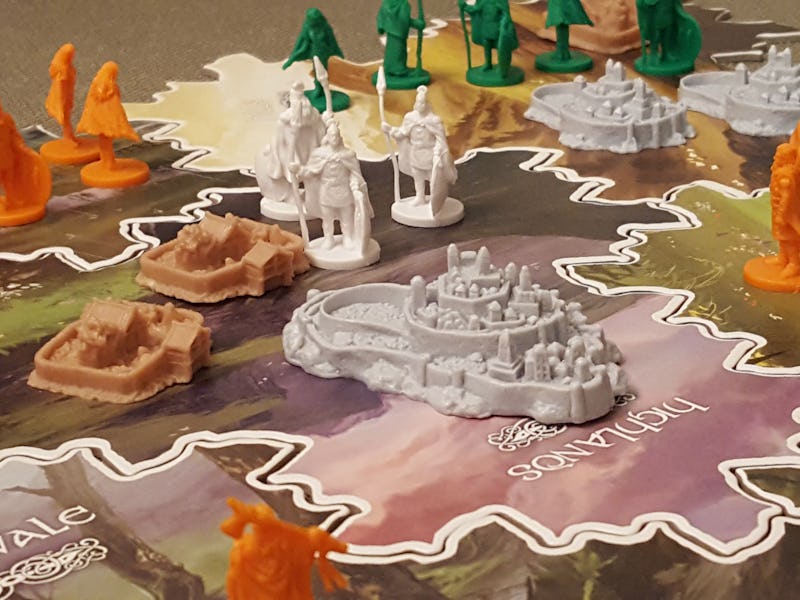The Most Beautiful Board Game of the Holiday Season Is Celtic as Hell
'Inis' is a feast for the mind and eyes -- but not much else.

When the new Celtic-themed tabletop game Inis is at its very best, playing it feels a bit like quaffing a foamy Irish stout. It’s rich, layered, and borderline chewable. What sets it apart is an emphasis on outwitting and outmaneuvering opponents. Although negotiation and battles are baked into Inis, the key to winning is maintaining a decent poker face for about an hour. Battles and negotiations are baked into the game — along with a “Festival” mechanic — but gameplay is weak, without real competition. The game is not, in and of itself, festive.
Inis gameplay is simple. Players play cards to add clans to the game map, move clans about the map, create buildings on the map, and alter the map itself. And as clans move around the board, players trying to fulfill victory conditions on their way to being crowned king of the island.
There are a few paths to victory, but they all, more or less, involve having the right number of your clans in the right number of territories. In a welcome departure from the certain figures-on-a-map games, combat is a means to an end, but not an end itself. This is a game of posture much more than it is one of slaughter.
Best Bits
Rounds resolve in two parts, the first of which is a card draft — not dissimilar to a Magic: the Gathering draft, if you’ve played that; if not, its essentially passing cards around a table to form the best possible hand of four. Each card does something different, and a few give you multiple options.
The Bard, for instance, can be played to earn an Epic Card or, if you kill off an enemy clan, a powerful Deed token. The Epic Cards offer new actions or reactions. They also overflow with the Celtic mythos, from stories that maybe ring a bell like the Tale of Cuchulain, or deep cuts, like the god Lug Samildanach and Manannan mac Lir, who shapes horses out of seafoam.
As you play the game, you begin to recognize the power of certain Action Card combinations. The Geis denies an opponent a crucial move, and following that card up with the Druid allows you to play it for yourself. With a smart and lucky draft, you can set yourself up to go on a warpath, with a grip full of cards that enable you fan out across the map and turn the inevitable fights in your favor.
You can go on the defense, fortifying your Inis toeholds with new citadel fortresses, which act as a safe space to weather invasions. Plopping the Festival token on the board tilts a territory of the map toward a neutral zone, with a penalty to whomever starts a brawl in the midst of a party.
Worst Bits
Though the game comes with a Warlord card to brawl, and Celtic lords to smite, it isn’t pulse-pounding. Do not expect epic battles. Braveheart, one must recall, was a Scottish affair. You take turns losing cards or figures, until all parties involved agree to a ceasefire, or there’s simply one player left standing.
A simple combat mechanic (you lose something, then I lose something) means battles go by quickly. But if you end up fighting against a superior force, minus a tide-turning action card or Epic Tale, do not expect to luck out and end the battle in your favor. There are very few ways to turn a pitched battle. This can be interpreted as a commentary on Irish history, but let’s leave that line of argumentation be for the moment.
The lack of randomness is why Inis works best as a two-player game. With straightforward actions and simple combat rules, it becomes a game of near-perfect information. The head game of predicting an opponent’s card — baiting out a canceling Geis so you can get away with what you really want to do — is stellar.
But the chess-like vibe diminishes with three or more players. With more players, the chances of a knock-down scenario increase. The danger becomes that the game will drag out into a Celtic whackamole, knocking back whichever player gets too close to fulfilling a victory condition without any of the other contenders being able to clinch that last maneuver for victory.
(You can avoid that outcome if you are sneaky enough to pull off a surprise march across the board, but that will take patience, and the perfectly drafted hand.)
The rulebook, unfortunately, has a few typos (you only have 18 total structures to build, not the stated 20). And some of the cards gained a sheen of ambiguity in translation. The Stone Circle ability only allows a player to remove his or her clan, not an opponent’s (the card says, ambiguously, just to remove one clan). The default house rule I’ve used is that if an interpretation of a card one way allows you to blow out your opponent, its probably the wrong interpretation.
Pretty Bits
Ireland has never looked lovelier in thick cardboard tiles and oversized cards. Artist Jim Fitzpatrick — whose most famous work is the Che Guevara portrait you’ve seen silkscreened on a tee shirt — executed a stunning art nouveau-meets Celtic “Heavy Metal” cover style. For the dudes-on-a-map genre, dominated by violence and High Fantasy, Middling Fantasy, Low Fantasy, Laser-sword and Raygun Fantasy, Greco-Roman Fantasy, Risky Global Domination Fantasy, or the occasional Egyptian or Viking Fantasy, Inis is a blast of fresh sea air.
If you’re looking for a raging brawler, though, the game’s Celtic dedication won’t save you. Like the gods drawn in beautiful, clean lines, Inis is elegant — but it’s a little too flat to be convincingly divine.